[English] 日本語
 Yorodumi
Yorodumi- PDB-8y6v: Near-atomic structure of icosahedrally averaged jumbo bacteriopha... -
+ Open data
Open data
- Basic information
Basic information
| Entry | Database: PDB / ID: 8y6v | |||||||||||||||
|---|---|---|---|---|---|---|---|---|---|---|---|---|---|---|---|---|
| Title | Near-atomic structure of icosahedrally averaged jumbo bacteriophage PhiKZ capsid | |||||||||||||||
 Components Components |
| |||||||||||||||
 Keywords Keywords | VIRUS / phiKZ / capsid protein / viral assembly / Pseudomonas aeruginosa / jumbo phage | |||||||||||||||
| Biological species |  Phikzvirus phiKZ Phikzvirus phiKZ | |||||||||||||||
| Method | ELECTRON MICROSCOPY / single particle reconstruction / cryo EM / Resolution: 3.5 Å | |||||||||||||||
 Authors Authors | Yang, Y. / Shao, Q. / Guo, M. / Han, L. / Zhao, X. / Wang, A. / Li, X. / Wang, B. / Pan, J. / Chen, Z. ...Yang, Y. / Shao, Q. / Guo, M. / Han, L. / Zhao, X. / Wang, A. / Li, X. / Wang, B. / Pan, J. / Chen, Z. / Fokine, A. / Sun, L. / Fang, Q. | |||||||||||||||
| Funding support |  China, 4items China, 4items
| |||||||||||||||
 Citation Citation |  Journal: Nat Commun / Year: 2024 Journal: Nat Commun / Year: 2024Title: Capsid structure of bacteriophage ΦKZ provides insights into assembly and stabilization of jumbo phages. Authors: Yashan Yang / Qianqian Shao / Mingcheng Guo / Lin Han / Xinyue Zhao / Aohan Wang / Xiangyun Li / Bo Wang / Ji-An Pan / Zhenguo Chen / Andrei Fokine / Lei Sun / Qianglin Fang /   Abstract: Jumbo phages are a group of tailed bacteriophages with large genomes and capsids. As a prototype of jumbo phage, ΦKZ infects Pseudomonas aeruginosa, a multi-drug-resistant (MDR) opportunistic ...Jumbo phages are a group of tailed bacteriophages with large genomes and capsids. As a prototype of jumbo phage, ΦKZ infects Pseudomonas aeruginosa, a multi-drug-resistant (MDR) opportunistic pathogen leading to acute or chronic infection in immunocompromised individuals. It holds potential to be used as an antimicrobial agent and as a model for uncovering basic phage biology. Although previous low-resolution structural studies have indicated that jumbo phages may have more complicated capsid structures than smaller phages such as HK97, the detailed structures and the assembly mechanism of their capsids remain largely unknown. Here, we report a 3.5-Å-resolution cryo-EM structure of the ΦKZ capsid. The structure unveiled ten minor capsid proteins, with some decorating the outer surface of the capsid and the others forming a complex network attached to the capsid's inner surface. This network seems to play roles in driving capsid assembly and capsid stabilization. Similar mechanisms of capsid assembly and stabilization are probably employed by many other jumbo viruses. | |||||||||||||||
| History |
|
- Structure visualization
Structure visualization
| Structure viewer | Molecule:  Molmil Molmil Jmol/JSmol Jmol/JSmol |
|---|
- Downloads & links
Downloads & links
- Download
Download
| PDBx/mmCIF format |  8y6v.cif.gz 8y6v.cif.gz | 2.9 MB | Display |  PDBx/mmCIF format PDBx/mmCIF format |
|---|---|---|---|---|
| PDB format |  pdb8y6v.ent.gz pdb8y6v.ent.gz | Display |  PDB format PDB format | |
| PDBx/mmJSON format |  8y6v.json.gz 8y6v.json.gz | Tree view |  PDBx/mmJSON format PDBx/mmJSON format | |
| Others |  Other downloads Other downloads |
-Validation report
| Arichive directory |  https://data.pdbj.org/pub/pdb/validation_reports/y6/8y6v https://data.pdbj.org/pub/pdb/validation_reports/y6/8y6v ftp://data.pdbj.org/pub/pdb/validation_reports/y6/8y6v ftp://data.pdbj.org/pub/pdb/validation_reports/y6/8y6v | HTTPS FTP |
|---|
-Related structure data
| Related structure data |  39002  38845  38846  38848 C: citing same article ( M: map data used to model this data |
|---|
- Links
Links
- Assembly
Assembly
| Deposited unit | 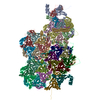
|
|---|---|
| 1 | x 60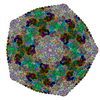
|
| 2 |
|
| 3 | x 5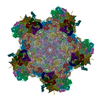
|
| 4 | x 6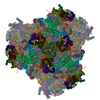
|
| 5 | 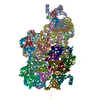
|
- Components
Components
-Protein , 11 types, 42 molecules DBEFGHKLMJabcdefghijklmnopqrst...
| #1: Protein | Mass: 36511.871 Da / Num. of mol.: 1 / Source method: isolated from a natural source / Source: (natural)  Phikzvirus phiKZ Phikzvirus phiKZ | ||||||||||||||||
|---|---|---|---|---|---|---|---|---|---|---|---|---|---|---|---|---|---|
| #2: Protein | Mass: 29713.783 Da / Num. of mol.: 1 / Source method: isolated from a natural source / Source: (natural)  Phikzvirus phiKZ Phikzvirus phiKZ | ||||||||||||||||
| #3: Protein | Mass: 16438.799 Da / Num. of mol.: 2 / Source method: isolated from a natural source / Source: (natural)  Phikzvirus phiKZ Phikzvirus phiKZ#4: Protein | | Mass: 48893.793 Da / Num. of mol.: 1 / Source method: isolated from a natural source / Source: (natural)  Phikzvirus phiKZ Phikzvirus phiKZ#5: Protein | | Mass: 20817.568 Da / Num. of mol.: 1 / Source method: isolated from a natural source / Source: (natural)  Phikzvirus phiKZ Phikzvirus phiKZ#6: Protein | Mass: 47656.105 Da / Num. of mol.: 3 / Source method: isolated from a natural source / Source: (natural)  Phikzvirus phiKZ Phikzvirus phiKZ#7: Protein | | Mass: 20253.990 Da / Num. of mol.: 1 / Source method: isolated from a natural source / Source: (natural)  Phikzvirus phiKZ Phikzvirus phiKZ#8: Protein | Mass: 83022.883 Da / Num. of mol.: 27 / Source method: isolated from a natural source / Source: (natural)  Phikzvirus phiKZ Phikzvirus phiKZ#9: Protein | Mass: 57705.137 Da / Num. of mol.: 3 / Source method: isolated from a natural source / Source: (natural)  Phikzvirus phiKZ Phikzvirus phiKZ#10: Protein | | Mass: 25300.836 Da / Num. of mol.: 1 / Source method: isolated from a natural source / Source: (natural)  Phikzvirus phiKZ Phikzvirus phiKZ#11: Protein | | Mass: 13427.183 Da / Num. of mol.: 1 / Source method: isolated from a natural source / Source: (natural)  Phikzvirus phiKZ Phikzvirus phiKZ |
-Experimental details
-Experiment
| Experiment | Method: ELECTRON MICROSCOPY |
|---|---|
| EM experiment | Aggregation state: PARTICLE / 3D reconstruction method: single particle reconstruction |
- Sample preparation
Sample preparation
| Component | Name: Phikzvirus phiKZ / Type: VIRUS / Entity ID: all / Source: NATURAL |
|---|---|
| Source (natural) | Organism:  Phikzvirus phiKZ Phikzvirus phiKZ |
| Details of virus | Empty: NO / Enveloped: NO / Isolate: STRAIN / Type: VIRION |
| Natural host | Organism: Pseudomonas aeruginosa |
| Virus shell | Triangulation number (T number): 27 |
| Buffer solution | pH: 7.5 |
| Specimen | Embedding applied: NO / Shadowing applied: NO / Staining applied: NO / Vitrification applied: YES |
| Specimen support | Grid material: COPPER / Grid type: EMS Lacey Carbon |
| Vitrification | Cryogen name: ETHANE |
- Electron microscopy imaging
Electron microscopy imaging
| Experimental equipment |  Model: Titan Krios / Image courtesy: FEI Company |
|---|---|
| Microscopy | Model: FEI TITAN KRIOS |
| Electron gun | Electron source:  FIELD EMISSION GUN / Accelerating voltage: 300 kV / Illumination mode: FLOOD BEAM FIELD EMISSION GUN / Accelerating voltage: 300 kV / Illumination mode: FLOOD BEAM |
| Electron lens | Mode: BRIGHT FIELD / Nominal magnification: 64000 X / Nominal defocus max: 2000 nm / Nominal defocus min: 1000 nm |
| Image recording | Electron dose: 30 e/Å2 / Film or detector model: GATAN K3 (6k x 4k) |
- Processing
Processing
| CTF correction | Type: PHASE FLIPPING AND AMPLITUDE CORRECTION |
|---|---|
| 3D reconstruction | Resolution: 3.5 Å / Resolution method: FSC 0.143 CUT-OFF / Num. of particles: 903900 / Symmetry type: POINT |
 Movie
Movie Controller
Controller


 PDBj
PDBj